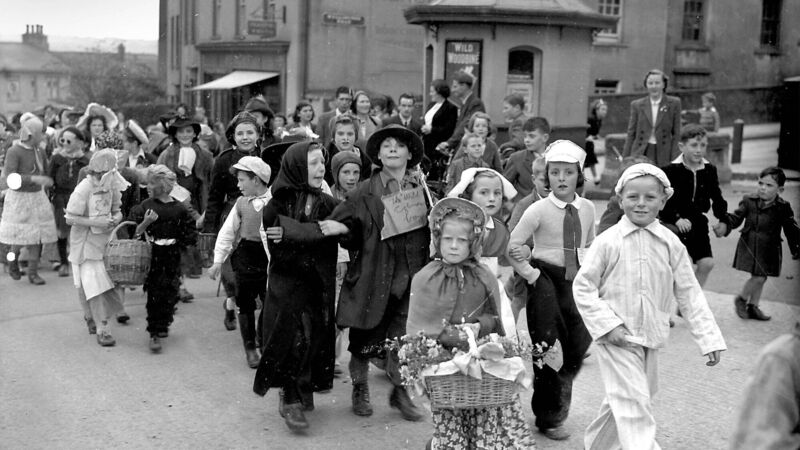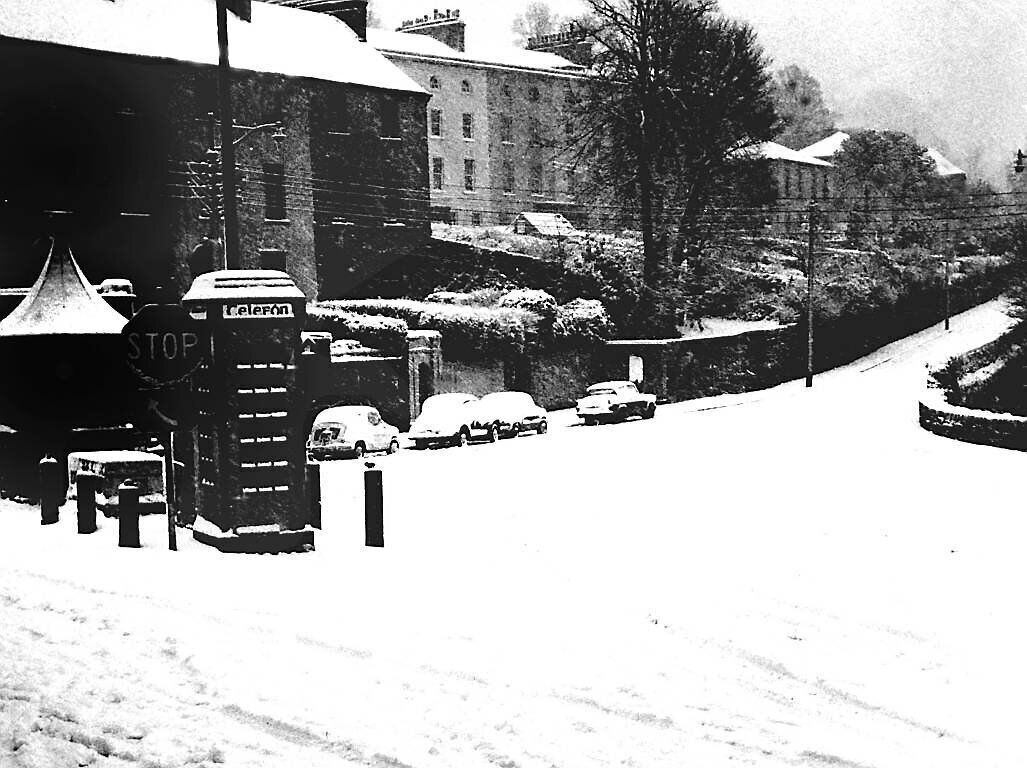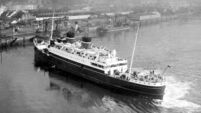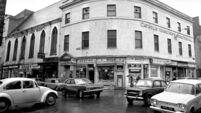Throwback Thursday: When St Luke’s had 3 schools and 5 pubs!

A Mayfield Carnival fancy dress parade passing the toll booth at St Luke’s Cross in Cork city on September 24, 1950. A reader remembers when St Luke’s was a thriving hub
THROWBACK Thursday reader John Kenny was delighted with the venerable Echo photo of the old St Patrick’s school at St Luke’s we ran a fortnight ago.
“As I grew up on the Ballyhooley Road, it brought back many memories to me,” he said. “Young readers of your popular weekly column may not know that it was here that a young Michael O’Donovan started school and was very fortunate to have as his teacher Daniel Corkery, who lived nearby on Gardiner’s Hill.
“Thus began O’Donovan’s life-long love for language and literature. Corkery was not to know that young O’Donovan, from Harrington’s Square, would give the oration at the graveside in Drumcliffe churchyard on the centenary year of W. B. Yeats’ death - for Michael O’Donovan became the writer Frank O’Connor, whom we all know about now.
“His mother’s maiden name was O’Connor and I have clear memories when I was a young fellow on the Ballyhooley Road, of O’Connor visiting friends of his in Windsor Cottages and Windsor Terrace.
“Mrs Horgan, of 2 Windsor Terrace , was a great friend of his mother. The Barry sisters of Windsor Cottages, who were active during the War of Independence, were also friends of his, as he himself was attached to Cork No.1 Brigade I.R.A.”
St Luke’s is still a fairly vibrant area, stresses Mr Kenny, “but, of course, like all places nowadays, it lacks much of the character which it had when I grew up in the area.
I remember when St Luke’s could boast, if indeed that is a boast, of having five public houses, a post office/library, a functioning horse trough, a toll house from which newspapers were sold, and a public phone box which was in constant use.
“It had two shoe repair shops, or bootmakers, as they were then called, a barber shop, a laundry and a Cudmore’s fruit shop. There was also a vegetable shop, a very elite grocery and provisions shop (Henchy’s), an ‘ordinary’ grocery and provisions store, and a bakery/confectioners.
“I mustn’t forget that St Lukes also of course had a butchers’ shop and a chemist’s shop. (You had everything in your own area back then, and didn’t have to drive miles to a huge anonymous supermarket.)
“The chemist shop was Allens and I remember being sent down to the chemist for a half gallon of paraffin oil. I had to bring a container of course. Can you imagine buying paraffin oil in a chemist today?

“In those times, the Department of Posts and Telegraphs used to publish a telephone directory, which would cover the whole country. I recall Allens’ chemist’s shop being the very first entry on the directory in the early 1950s. I am open to correction about this, if anyone knows better!
“In addition to all that, it had a Garda station with a live-in sergeant and his family. There were three schools, and a Church of Ireland church called, of course, St Luke’s.”
Phew - with all of that, it couldn’t but have been a place of great character!
However, John says he just doesn’t know how the area came to be called St Luke’s.
The sign over the then post office clearly read ‘Crosaire na mBocht’, as I think the existing post office also does. I think that name related to the Famine times.
“By the way,” adds John, “I went to St Patrick’s infant school myself, and I remember doing my sums and alphabet on a slate with chalk!” Another reader, Tim Cagney, also has memories of that old educational establishment. “My parental home was next door to the front entrance of St Patrick’s Boys’ School - our back-garden overlooked it. I can remember when the Girls’ School didn’t exist. The land it now occupies used to be called Kiely’s Field. That was used for a big fire on ‘Bonna Night’, with much of the fuel (tree branches mostly) being ‘borrowed’ from the grounds of the Haunted House on Lover’s Walk.
“My late brother and I always had a grandstand view of the conflagration from our bedroom window. The embers would still be burning the following morning.”
Pat Kelly was also inspired to write in after reading last week’s Throwback Thursday pages.

“Your piece again brought back memories as regards food waste,” said Pat. “My grandmother was from Mourneabbey, and she would bake her bread in a bastible, where she would take the fire grate out of the fireplace to fit the pot in. She would make soda bread, and she would put in caraway seeds and, if she had some, also dried fruit.
“My mam would make a kind of blancmange with the edible seaweed known as Carrageen Moss. It was delicious. Leftovers from Sunday dinner, potatoes and cabbage, would be fried up for Monday’s meal. It was nice and crispy. But anything leftover, like potato skins and other stuff, would be given to the man who came by with his donkey and cart, for his pigs.
My brother and I used to use the back of spoons to scoop out the marrow of beef bones.
“The only fruit that we would have in season were orange pippins, which were delicious. However, we regularly had syrup of figs, cascara, cod liver oil, Scotts Emulsion, etc, whether we need them or not! Most mothers were anxious about keeping their children healthy.
“I remember nutmeg graters, and those large Berkel slicers they had in Maddens of Bridge Street.
“We would bring papers to school, where the bishop used them for making money. Recycling? We were masters at recycling back then, before it became a trendy fashion.
“As Charles Dickens might have said, we had the best of times, and the worst of times. I do not know where to stop, as you have resurrected memories that were stored in the deep recesses of my mind. Thanks, Jo!”
Eileen Barry wrote in to say: “Just read your article on leftover food. It’s a terrible shame that people don’t always respect food. Like you, I remember leftovers, mincing machines, shepherd’s pies and meat pies. Cooked potatoes have, to this day, been a stalwart in our house... mashed potato for the next meal (heated up in milk with a few chopped chives or parsley, salt and pepper. Then, there’s potato cakes (mashed potato with some flour, rolled out and cut into squares or rounds, whichever). There is an ongoing dispute in our family about salt or sugar. I, personally, love melted butter (or your choice of spread) and a sprinkling of salt on my potato cakes. The other camp prefers butter and a good sprinkle of sugar (YUK!).
“Chopped up cooked potatoes make great addition to a teatime fry (I like them thin, others like them chunky). And, if you happen to be using the oven to cook some meat, pop in a few cooked potatoes to ‘roast’ (rubbed with oil, or ground semolina and a bit of seasoning of course).
Sometime, as a treat, we go for breakfast to a well-respected fully Irish ‘fast food’ chain (born in Mayo, you know who you are!).
“The breakfasts are massive and delicious, but a little too much for me (over 70, meant to eat less!).
“I might order a DIY breakfast, but it’s nice to go the whole hog occasionally. That means that Household Dog has a little of my breakfast sausage or rasher that day (and evening, and the following morning.). I have to admit, in the same eating place, to sneaking some of someone’s unfinished breakfast into a napkin for self-same Dog. That’s in the ‘short window’ of opportunity after the table is vacated and staff elsewhere. Me looking around surreptitiously to make sure no-one has noticed, of course.
“I wonder, should I be braver and ask the workers what happens to unfinished food? Or ask for a doggy bag, if anyone remembers that?”
Lovely memories, Eileen, and thank you for sharing them. This writer can remember dining with some American visitors quite a few years back. When they had finished, they requested just such a ‘doggy bag’ and immediately got it, no problem. In that same restaurant, if I had dared to do such a thing back then, I would have been stared at.
“It’s a bit different now, thankfully - they are all geared up to wrap your leftovers and they can be very handy for a snack the following day.
(And I will never forget our hostess in a guest house up in Connemara throwing another sausage into the pan when she saw the dogs outside in the car looking eagerly at the kitchen window. “Ah sure, wouldn’t they want one for themselves, and why not?”)
Meanwhile, Frank Desmond has written to point out helpfully that shepherd’s pie can easily be bought these days, commercially pre-prepared, plastic-wrapped, date-stamped, from the shelves at Tesco. Not quite the same thing is it, Frank? The whole point is that our parents and grandparents used up every scrap of leftovers to make another nourishing meal.
The very notion of going out and spending what little cash they had on something prepared and packed elsewhere would have been anathema to them. Even if it had been available, which generally it wasn’t.
As regards both cost and quality, cooking stayed at home in those days.
Yes, these days you can certainly buy anything you want, from Asian street food to Italian pizza, caviar to crudités, as long as your pocket is deep enough. Our forbears didn’t have that option. They probably wouldn’t have wanted it!
One has to wonder what Grandma or Great Aunt Catherine would think if she stood in Patrick Street today and saw the Deliveroo and Just Eat bikes whisking by, taking ready meals to people, some of whom wouldn’t know how to open an oven door, or, heaven forfend, host a home-cooked dinner party!
Tim Cagney takes the whole topic that bit further, into the realm of Make Do and Mend.
“Just reading your comments on food-wastage these days, as compared with the culinary economies imposed by limited financial means, in days gone by, I couldn’t agree more, and neither could my wife.
When she was just five, she was whisked off to Kerry, where her father had inherited a pub in Killorglin, They had all been living in Dublin, but, in those days, saying no just wasn’t an option.
“Margaret tells many stories of what life was like in Kerry then, compared to the ‘luxuries’ one might find in Dublin. Fresh vegetables and fruit were surprisingly scarce in the country. Added to this was the fact that we were still in the throes of post-war rationing, not to mention the meagre incomes many of our forebears managed to bring in.
“This had the effect of inculcating - in Margaret at any rate - an absolute abhorrence of waste of any kind, especially food, which still lives with her today.
“I will admit that I am of a similarly frugal disposition. Mine, however, goes beyond food - I am a firm advocate of repairing things, rather than discarding them in favour of buying replacements. Luckily, I happen to be ‘handy’ at doing such things.
“About 30 years ago, Margaret bought me a power-drill. Around 10 years ago, it stopped working. I took it apart, to find the armature bushes had simply worn-down. I acquired a new set for a tenner, and - bingo - the machine is in flying form, once again.
“The only downside of this, of course, is that I tend to ‘acquire’ things, for example three Hoovers, five televisions, and so forth. A recent example of such thrift was a Dyson cordless vacuum-cleaner, which showed signs of no longer being capable of fully re-charging its battery pack. We got a new one, but I retained the older model, which I now use to hoover-up the debris from my shaver! A tad extreme, perhaps, but waste not, want not.”
We hear you, Tim, and three cheers for those still left who can change a fuse, re-hang a hinge, sew on a button, or take the coffee grinder into the workshop with the comforting words, “let’s see what we can do with this.” Are there many of you left?
Tell us your memories. Email jokerrigan1@ gmail.com. Or leave a comment on our Facebook page: https://www.facebook.com/echolivecork.







